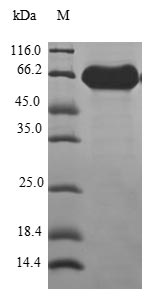The region for expressing recombinant Human ATP6V0D1 contains amino acids 1-351. The theoretical molecular weight of the ATP6V0D1 protein is 67.3 kDa. This ATP6V0D1 recombinant protein is manufactured in e.coli. The N-terminal GST tag was fused into the coding gene segment of ATP6V0D1, making it easier to detect and purify the ATP6V0D1 recombinant protein in the later stages of expression and purification.
Researchers are actively exploring the functions of V-type proton ATPase subunit d 1 (ATP6V0D1). This protein is involved in the formation of the intracellular V-type ATPase complex, crucial for regulating the cellular pH balance. In cancer research, scientists have found a connection between ATP6V0D1 and tumor growth and invasion, suggesting it as a potential target for anti-cancer treatments. Additionally, in the field of neuroscience, ATP6V0D1 is closely associated with synaptic transmission in neurons and membrane transport processes, playing a significant role in the normal functioning of the nervous system. Recent studies have also identified its regulatory role in immune cells, providing a new perspective for research in immunology and autoimmune diseases.






